Blog & Latest Updates
Fly Fishing Articles
Insects by Common Name


Mayfly Family Heptageniidae (March Browns, Cahills, Quill Gordons)
Taxonomic Navigation -?-
Kingdom
Animalia (Animals)
» Phylum
Arthropoda (Arthropods)
» Class
Insecta (Insects)
» Order
Ephemeroptera (Mayflies)
» Family Heptageniidae (March Browns, Cahills, Quill Gordons)
4 genera aren't included.
Common Name
| Match | Common Name |
| March Browns, Cahills, Quill Gordons |
This is page 3 of specimens of Heptageniidae. Visit the main Heptageniidae page for:
- The behavior and habitat of Heptageniidae.
- 11 underwater pictures of Heptageniidae.
Pictures of 215 Mayfly Specimens in the Family Heptageniidae:
Epeorus (Little Maryatts) Mayfly Nymph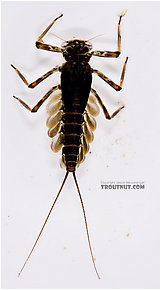 View 9 Pictures
View 9 Pictures
 View 9 Pictures
View 9 PicturesCollected May 6, 2007 from Mongaup Creek in New York
Added to Troutnut.com by Troutnut on May 18, 2007
Added to Troutnut.com by Troutnut on May 18, 2007
Male Nixe inconspicua Mayfly Dun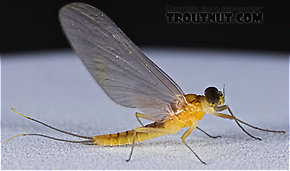 View 13 PicturesThis pretty little dun was part of a sparse midsummer evening hatch on a large Catskill river.
View 13 PicturesThis pretty little dun was part of a sparse midsummer evening hatch on a large Catskill river.
I could not identify it by following a species key step by step, but I tentatively keyed it to the genus Nixe, and based on distribution maps and physical descriptions the most likely species is Nixe inconspicua.
 View 13 PicturesThis pretty little dun was part of a sparse midsummer evening hatch on a large Catskill river.
View 13 PicturesThis pretty little dun was part of a sparse midsummer evening hatch on a large Catskill river.I could not identify it by following a species key step by step, but I tentatively keyed it to the genus Nixe, and based on distribution maps and physical descriptions the most likely species is Nixe inconspicua.
Collected July 13, 2005 from the East Branch of the Delaware River in New York
Added to Troutnut.com by Troutnut on April 14, 2006
Added to Troutnut.com by Troutnut on April 14, 2006
Male Cinygmula (Dark Red Quills) Mayfly Spinner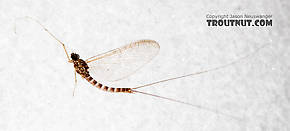 View 11 PicturesI'm unsure of the ID on this one; keys put it closest to Cinygmula reticulata, but I'm very doubtful of the species and not positive on the genus. Epeorus is another possibility, but I don't know which species it would be.
View 11 PicturesI'm unsure of the ID on this one; keys put it closest to Cinygmula reticulata, but I'm very doubtful of the species and not positive on the genus. Epeorus is another possibility, but I don't know which species it would be.
This one was collected in association with a female dun probably of the same species.
 View 11 PicturesI'm unsure of the ID on this one; keys put it closest to Cinygmula reticulata, but I'm very doubtful of the species and not positive on the genus. Epeorus is another possibility, but I don't know which species it would be.
View 11 PicturesI'm unsure of the ID on this one; keys put it closest to Cinygmula reticulata, but I'm very doubtful of the species and not positive on the genus. Epeorus is another possibility, but I don't know which species it would be.This one was collected in association with a female dun probably of the same species.
Collected July 1, 2017 from the South Fork Stillaguamish River in Washington
Added to Troutnut.com by Troutnut on July 2, 2017
Added to Troutnut.com by Troutnut on July 2, 2017
Maccaffertium ithaca (Light Cahill) Mayfly Nymph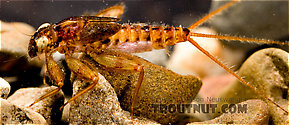 View 9 PicturesThis specimen seems to be of the same species as a dun I photographed which emerged from another nymph in the same sample.
View 9 PicturesThis specimen seems to be of the same species as a dun I photographed which emerged from another nymph in the same sample.
 View 9 PicturesThis specimen seems to be of the same species as a dun I photographed which emerged from another nymph in the same sample.
View 9 PicturesThis specimen seems to be of the same species as a dun I photographed which emerged from another nymph in the same sample.Collected May 29, 2007 from Paradise Creek in Pennsylvania
Added to Troutnut.com by Troutnut on June 4, 2007
Added to Troutnut.com by Troutnut on June 4, 2007
Maccaffertium ithaca (Light Cahill) Mayfly Dun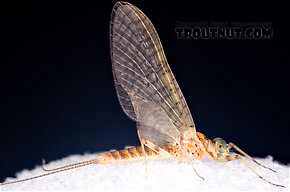 View 9 PicturesThis dun emerged from a nymph in one of the bowls on my table while I was sorting. I photographed it with the nymphal shuck (
View 9 PicturesThis dun emerged from a nymph in one of the bowls on my table while I was sorting. I photographed it with the nymphal shuck (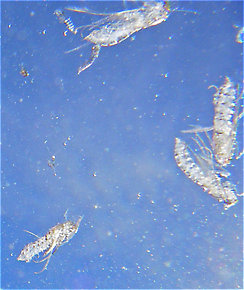 Shuck: The shed exoskeleton left over when an insect molts into its next stage or instar. Most often it describes the last nymphal or pupal skin exited during emergence into a winged adult.), and it seems to be of the same species as a nymph I photographed from the same sample.
Shuck: The shed exoskeleton left over when an insect molts into its next stage or instar. Most often it describes the last nymphal or pupal skin exited during emergence into a winged adult.), and it seems to be of the same species as a nymph I photographed from the same sample.
 View 9 PicturesThis dun emerged from a nymph in one of the bowls on my table while I was sorting. I photographed it with the nymphal shuck (
View 9 PicturesThis dun emerged from a nymph in one of the bowls on my table while I was sorting. I photographed it with the nymphal shuck (
Here's an underwater view of the pupal shucks of several already-emerged Brachycentrus numerosus caddisflies.
Collected May 29, 2007 from Paradise Creek in Pennsylvania
Added to Troutnut.com by Troutnut on June 4, 2007
Added to Troutnut.com by Troutnut on June 4, 2007
Female Heptageniidae (March Browns, Cahills, Quill Gordons) Mayfly Dun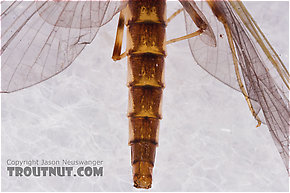 View 10 PicturesThis specimen is really strange, very different in form from any other mayfly I've seen. Unfortunately it was found alone crippled in an eddy and in pretty bad shape, and I couldn't find any others like it.
View 10 PicturesThis specimen is really strange, very different in form from any other mayfly I've seen. Unfortunately it was found alone crippled in an eddy and in pretty bad shape, and I couldn't find any others like it.
 View 10 PicturesThis specimen is really strange, very different in form from any other mayfly I've seen. Unfortunately it was found alone crippled in an eddy and in pretty bad shape, and I couldn't find any others like it.
View 10 PicturesThis specimen is really strange, very different in form from any other mayfly I've seen. Unfortunately it was found alone crippled in an eddy and in pretty bad shape, and I couldn't find any others like it.Collected June 28, 2005 from the Long Lake Branch of the White River in Wisconsin
Added to Troutnut.com by Troutnut on May 26, 2006
Added to Troutnut.com by Troutnut on May 26, 2006
Epeorus vitreus (Sulphur) Mayfly Nymph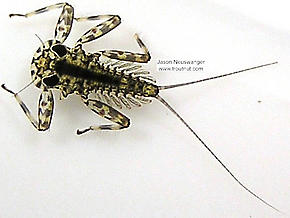 View 6 Pictures
View 6 Pictures
 View 6 Pictures
View 6 PicturesCollected February 7, 2004 from unknown in Wisconsin
Added to Troutnut.com by Troutnut on January 25, 2006
Added to Troutnut.com by Troutnut on January 25, 2006
Male Stenacron interpunctatum (Light Cahill) Mayfly Spinner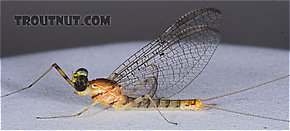 View 8 Pictures
View 8 Pictures
 View 8 Pictures
View 8 PicturesCollected June 10, 2005 from the Namekagon River in Wisconsin
Added to Troutnut.com by Troutnut on May 26, 2006
Added to Troutnut.com by Troutnut on May 26, 2006
Male Rhithrogena morrisoni (Western March Brown) Mayfly Spinner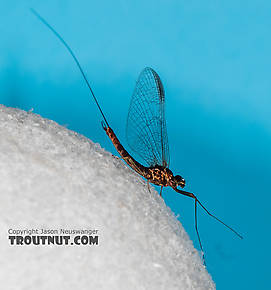 View 9 Pictures
View 9 Pictures
 View 9 Pictures
View 9 PicturesCollected June 22, 2017 from the South Fork Snoqualmie River in Washington
Added to Troutnut.com by Troutnut on June 23, 2017
Added to Troutnut.com by Troutnut on June 23, 2017
Female Rhithrogena Mayfly Spinner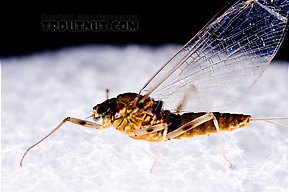 View 9 PicturesI'm very tentatively (see the connected forum thread) sticking this mayfly in Rhithrogena for now.
View 9 PicturesI'm very tentatively (see the connected forum thread) sticking this mayfly in Rhithrogena for now.
 View 9 PicturesI'm very tentatively (see the connected forum thread) sticking this mayfly in Rhithrogena for now.
View 9 PicturesI'm very tentatively (see the connected forum thread) sticking this mayfly in Rhithrogena for now.Collected June 7, 2007 from the West Branch of the Delaware River in New York
Added to Troutnut.com by Troutnut on June 8, 2007
Added to Troutnut.com by Troutnut on June 8, 2007
Top 10 Fly Hatches
Top Gift Shop Designs
Eat mayflies.
Top Insect Specimens
Miscellaneous Sites
Troutnut.com is copyright © 2004-2024 Jason
Neuswanger (email Jason). See my FAQ for information about use of my images.
 privacy policy
privacy policy
